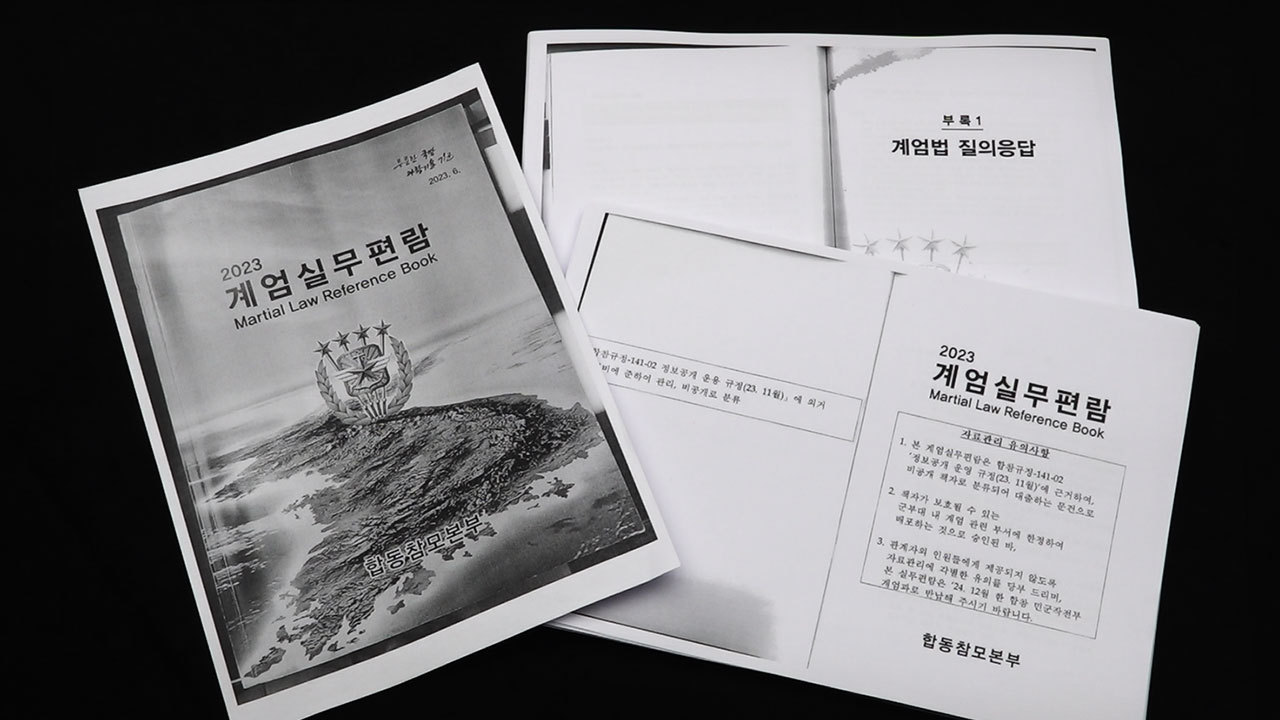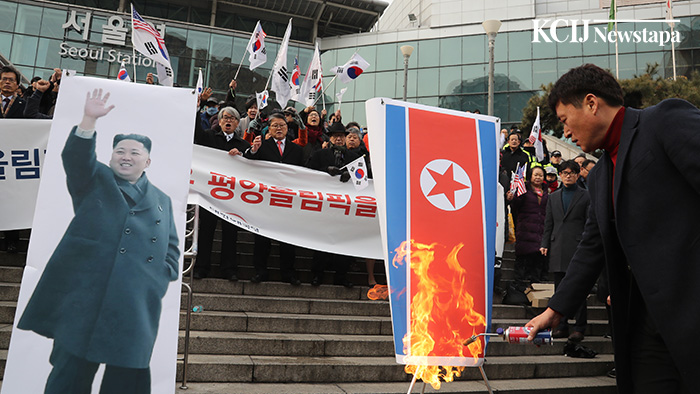
S. Korean Martial Law, A Gag Order to its People and the Press
2024년 12월 20일 13시 02분
As South Koreans celebrate the cooling of tensions with North Korea as a result of the Olympics Truce, the Trump administration and US foreign policy hardliners are doing everything they can to dampen expectations for a renewed peace process.
Even as the historic agreements were made for North and South to march into the Olympics together and transport their respective delegations back and forth across the DMZ, the White House and the Pentagon were reminding the world that the United States was fully prepared to use its military might if Kim Jong Un continues to test missiles and nuclear weapons after the Games.

At the same time, the US media was giving voice to conservative US critics of North-South détente who claim that Kim Jong Un, through his outreach to Seoul, is trying to “drive a wedge” between the US and South Korea. It is also exaggerating the political divisions inside South Korea over the agreement by North and South to form a united women’s hockey team and compete together in other sports.
On Monday, the The New York Times, America’s newspaper of record for the foreign policy elite, ran an extremely biased story about the North Korean delegation to Seoul led by the entertainer-turned-official Hyon Song-wol. Under the headline, “Protesters in Seoul Burn Image of Kim Jong-un During North Koreans’ Visit,” it described what sounded like a huge riot of Seoul citizens against Kim Jong Un and Hyon’s inspection tour.

But the story – which was reported from a reporter Hong Kong and not by the Times’ Seoul bureau chief Choe Sang-hun- failed to mention that the protest was tiny and led by Rep. Cho Won-jin of the one-seat Patriotic Party of Korea. Apparently the reporter didn’t know that Cho’s party is so far to the right that it believes Park Geun-hye was unlawfully impeached and denies the legitimacy of the Moon government.
Coverage like this lends credence to US conservatives who believe that South Korea is being manipulated into its Olympic Truce by Kim Jong Un. That charge was made last week by Republican Senator Lindsey Graham, who has previously said that a US military strike on North Korea would be acceptable because the war would be “over there” and not in the USA. Speaking of Moon’s talks with the Kim government, he said: “South Korea is undercutting Trump on the North’s nuclear program” and therefore “sending the wrong message.”
Meanwhile, just as the North-South talks were starting, the Pentagon and the US Air Force deployed nuclear-armed B-52 “Stratofortresses,” B-2 stealth and B1-B bombers to a US base in Guam, bringing the three aircraft together for only the second time in history. They are there to reinforce the US Pacific Command’s “continuous bomber presence mission” aimed at North Korea, US officials said.
A day later, a senior Republican congressman who chairs the important House Armed Services committee told reporters that the US military was conducting “very serious” training for a military conflict with Pyongyang. The Trump administration is “looking at what would be involved with military options when it comes to North Korea,” said Rep. Mac Thornberry.
On Monday, Mike Pompeo, the director of the CIA and a close confidante of President Trump, said that military preparations like these are necessary because North Korea is only a “handful of months” away from placing a nuclear weapon on an ICBM and hitting the United States. The North’s weapons program “is continuing to expand, advance, become more powerful, more capable, more reliable,” he told CBS News.

A few days earlier, Trump used that knowledge to argue against the possibility of following President Moon Jae-in in direct talks with North Korea. “I’d sit down, but I‘m not sure that sitting down will solve the problem,” he told Reuters. He also warned that while North Korea was not yet capable of delivering a ballistic missile to the United States, “they’re close — and they get closer every day.”
By and large, Trump and his allies in Washington’s think tanks view the prospect of peace talks and an Olympic truce as problematic. Once again the line was established in the Times. Under the title, “Olympic Détente Upends U.S. Strategy on North Korea,” it reported that White House officials are warning that “the ultimate goal of Mr. Kim is to evict American troops from the Korean Peninsula and to reunify the two Koreas under a single flag.” That goal, the paper said, strengthens the hawk’s argument that “Kim cannot be deterred peacefully as the Soviet Union was during the Cold War.”
The idea that deterrence cannot work against North Korea is now being used by many US analysts to say that military force – such as the “bloody nose” strike against the North suggested by H.R. McMaster, Trump’s national security adviser - as America’s only alternative if Kim doesn’t willingly give up his weapons.
In other words, their thinking goes, while arms control agreements and a substantial military buildup held China and the Soviet Union in check during the Cold War, they don’t believe those arrangements will not work with Kim Jong Un and North Korea. And if the North doesn’t immediately give up its weapons, it will face a war.
That argument, and the criticism of the Olympic truce by US officials, may have triggered President Moon’s comments on Monday pleading for international and domestic support for his engagement policies with North Korea. “We are facing a very precious opportunity to peacefully resolve the North Korean nuclear issue and establish peace on the Korean Peninsula,” Moon said, according to Yonhap.
The contrast between South Korean and US attitudes was underscored last week during an unusual meeting in Vancouver, Canada, of foreign ministers from countries that fought with the US-run UN Command during the Korean War. Japan, which of course did not fight in the war but greatly profited from it, was also present.
The meeting, which was attended by foreign minister Kang Kyung-wha, was supposed to “demonstrate international solidarity” for diplomatic efforts to stop North Korea’s nuclear and missile programs. But the primary goal – decided by the US - was to win support for an aggressive program of maritime interdiction to prevent the Kim government from taking measures at sea to evade UN-imposed sanctions on oil, textiles and other products.
“If North Korea does not choose the path of engagement, discussion, negotiation,” Secretary of State Tillerson said in his opening address, “then they themselves will trigger an option." By that, of course, he means a military option.
Hoping to influence the discussions in Vancouver, 16 women representing peace groups from the US, Canada and other countries came to the the conference to press for diplomatic and economic initiatives to peacefully resolve the Korea crisis and ultimately bring a formal end to the Korean War through a peace treaty. They managed to arrange meetings with Canada’s foreign minister Freeland and officials from the State Department. They also held a candlelight vigil calling for more women to be included in the peace process.

“We feel it’s really important to hold these foreign ministers to account,” Christine Ahn, the founder and international coordinator of Women Cross DMZ, the prime mover behind the “Vancouver Women’s Forum,” told Newstapa. “The countries that sent soldiers, doctors and nurses to Korea as part of the US-controlled UN Command also have a responsibility to finally end the Korean War.”
In addition to Women Cross DMZ, the groups in Vancouver were The Nobel Women’s Initiative organized by six Nobel laureates; Canadian Voice of Women for Peace, a non-partisan group that works closely with the United Nations; the United Church of Canada, a major Protestant denomination; and the Women’s International League for Peace and Freedom, which was established in 1915. Two women from South Korea representing the National Council of Churches in Korea and the People’s Solidarity for Participatory Democracy, a powerful citizens’ group, are also at the meeting. The US-based Win Without War participated as well.
After the US meeting ended, the women’s groups issued a statement critical of the foreign ministers. “Instead of supporting the reduction of tensions in the Korean peninsula that began with the inter-Korean dialogue and the Olympics truce, the Foreign Ministers chose to further isolate and threaten North Korea,” they said.
뉴스타파는 권력과 자본의 간섭을 받지 않고 진실만을 보도하기 위해, 광고나 협찬 없이 오직 후원회원들의 회비로만 제작됩니다. 월 1만원 후원으로 더 나은 세상을 만들어주세요.